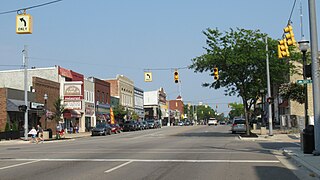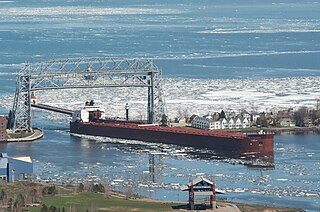
Ludington is a city in the U.S. state of Michigan. It is the county seat and the largest city in Mason County. The population was 7,655 at the 2020 census.

U.S. Route 10 or U.S. Highway 10 (US 10) is an east–west United States Numbered Highway located in the Midwest and Great Lakes regions of the U.S. Despite the "0" as the last digit in the number, US 10 is no longer a cross-country highway, and it never was a full coast-to-coast route. US 10 was one of the original long-haul highways, running from Detroit, Michigan, to Seattle, Washington, but then lost much of its length when new Interstate Highways were built on top of its right-of-way.
The Pere Marquette Railway was a railroad that operated in the Great Lakes region of the United States and southern parts of Ontario in Canada. It had trackage in the states of Michigan, Ohio, Indiana, and the Canadian province of Ontario. Its primary connections included Buffalo; Toledo; and Chicago. The company was named after Jacques Marquette, a French Jesuit missionary who founded Michigan's first European settlement, Sault Ste Marie.
Michigan Shipwreck Research Association (MSRA) is an American non-profit corporation based in Holland, Michigan. Formed in 2001 by the former directors of the committee which originally established the Southwest Michigan Underwater Preserve, their stated purpose is to "Preserve Michigan’s Submerged Maritime History." With the discovery of the steamer H. C. Akeley outside the boundaries of the preserve, the group broadened their area of focus and formed MSRA.

SS Badger is a passenger and vehicle ferry in the United States that has been in service on Lake Michigan since 1953. Currently, the ship shuttles between Ludington, Michigan, and Manitowoc, Wisconsin, a distance of 62 miles (100 km), connecting U.S. Highway 10 (US 10) between those two cities. She is the last coal-fired passenger vessel operating on the Great Lakes, and was designated a National Historic Landmark on January 20, 2016.
The Flint and Pere Marquette Railroad (F&PM) is a defunct railroad which operated in the U.S. state of Michigan between 1857 and 1899. It was one of the three companies which merged to become the Pere Marquette Railway.

The history of commercial passenger shipping on the Great Lakes is long but uneven. It reached its zenith between the mid-19th century and the 1950s. As early as 1844, palace steamers carried passengers and cargo around the Great Lakes. By 1900, fleets of relatively luxurious passenger steamers plied the waters of the lower lakes, especially the major industrial centres of Chicago, Milwaukee, Detroit, Cleveland, Buffalo, and Toronto.

HMS Little Belt was the mercantile sloop Friends Good Will, launched in 1811, which the British captured shortly after the start of the War of 1812. The British took her into service as Little Belt, armed her with three guns, and incorporated her into the Royal Navy's Lake Erie fleet. The American schooner Scorpion captured her during the Battle of Lake Erie and the Americans took her into service under her existing name. A storm drove her ashore in October 1813 and a British expeditionary force burnt her in December 1813.
HMS Chippawa, or Chippeway, was the mercantile schooner Chippawa, built and launched in 1810. The British brought her into service as HM Schooner Chippawa, sometimes recorded as Chippeway.
Two ships of the United States Coast Guard or its antecedent services have borne the name Sherman, in honor of John Sherman (1823–1900), who was Secretary of the Treasury during the Hayes administration (1877–1881).

SS Spartan is a railroad car ferry on Lake Michigan owned by the Chesapeake and Ohio Railway (C&O) from 1952 through 1979. It alternated routes from Ludington, Michigan, to Milwaukee, Kewaunee, and Manitowoc, Wisconsin.

Queen of the Lakes is an unofficial but widely recognized title bestowed upon vessels on the Great Lakes of the United States and Canada, honoring the largest vessel currently in service on the lakes. A number of vessels, mostly lake freighters, have been known by the title. Since 1981, the title has been held by MV Paul R. Tregurtha, a lake freighter of the 1000-foot category operated by the Interlake Steamship Company. MV Paul R. Tregurtha is 1,013.5 ft (308.9 m) long, and is the longest-running holder of the title.

The Great Lakes Patrol was carried out by American naval forces, beginning in 1844, mainly to suppress criminal activity and to protect the maritime border with Canada. A small force of United States Navy, Coast Guard, and Revenue Service ships served in the Great Lakes throughout these operations. Through the decades, they were involved in several incidents with pirates and rebels.

The SS Pere Marquette was the world's first steel train ferry. It sailed on Lake Michigan and provided a service between the ports of Ludington, Michigan, and Manitowoc, Wisconsin, for the Pere Marquette Railway from 1897 to 1930. The railway used the name Pere Marquette for many of its ships and ferries, adding a number to the end of the name.

SS Pere Marquette 18 was a steel-hulled Great Lakes train ferry that served on Lake Michigan from her construction in 1902 to her sinking in 1910.

SS Russia was an iron-hulled American Great Lakes package freighter that sank in a Lake Huron gale on April 30, 1909, near DeTour Village, Michigan, with all 22 of her crew and one passenger surviving.
Interlake Maritime Services is an American shipping firm that was created in December 2020 after Interlake Steamship Company purchased the assets of Pere Marquette Shipping Company and Lake Michigan Car Ferry Company, including the car ferry SS Badger, MT Undaunted, ATB Pere Marquette 41, SS Spartan, and MG Winfield Scott (LT-805). Its corporate headquarters is located in Middleburg Heights, a suburb of Cleveland, Ohio, with additional regional offices in Duluth, Minnesota, and Ludington, Michigan.

PS Keystone State was a wooden-hulled American paddle steamer in service between 1849 and 1861. She was built in 1848 in Buffalo, New York, by Bidwell & Banta for ship-owner Charles M. Reed of Erie, Pennsylvania, and operated as part of his "Chicago Line". A luxuriously furnished palace steamer, she operated between Buffalo and Chicago, Illinois, while also making stops at various other ports. She was built for the passenger and package freight trade, frequently carrying both wealthy passengers and European immigrants who desired to settle in the Midwestern United States. Due to the Panic of 1857, Keystone State and several other paddle steamers were laid up. When the American Civil War began in 1861; she was refurbished, and put back into service.
USRC Ingham was the second ship of the Harrison schooner class, which was built and operated by the United States Revenue Cutter Service between 1849 and 1856. She is the third ship of the Revenue Cutter Service to bear the name.














